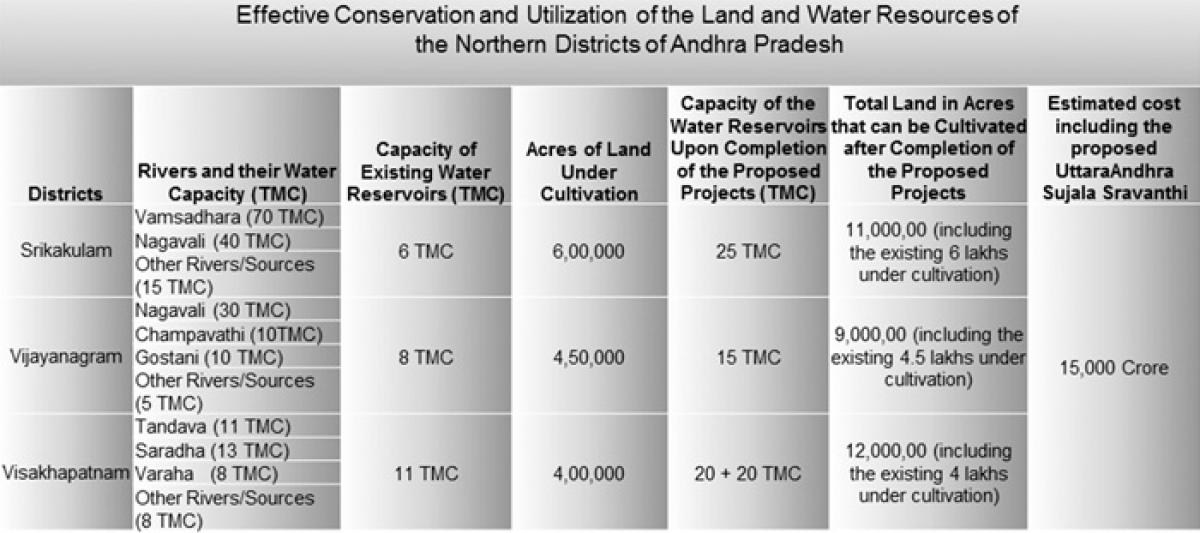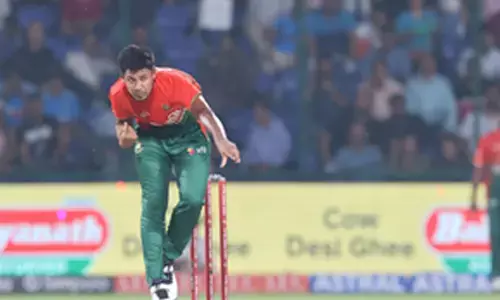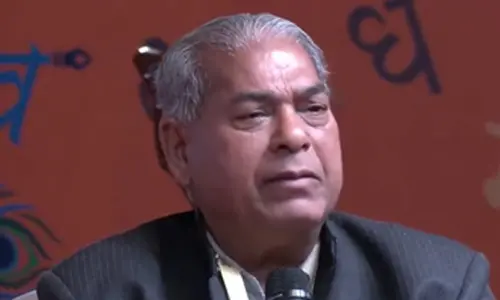Why Should UttaraAndhra Shed Tears when they have plenty of Water Sources at their Disposal?

Water Water Everywhere, not a Drop to Drink The Sorrowful State of UttaraAndhra Districts Shedding Tears for a Drop Water amidst Plenty
It is a notable place for revolutionary ideologies, where the political and literary stalwarts and legendaries have originated from this land and have laid foundation for social reformations. It is a land studded with precious lush green gardens and horsing sea coasts. There are not enough words to describe the natural beauty of this region as it is blessed with breathtaking meadows, rivers and waterfalls that flow surrounding the mountain stretches, furnished with forest greenery and they are none other than ‘UttaraAndhra’, Northern Andhra Pradesh districts in the South Indian state of Andhra Pradesh. Yet, this region is shedding sorrowful tears because the people of this region could not quench their thrust. The perennial water bodies that are flowing through these districts could not supply water to meet the drinking and irrigational needs of the region. It may sound very strange, as the ‘truth is always stranger than fiction!’
Had we been able to make the best use of the water and the other natural resources available here, we would have been the best northern districts of the state. Our inability to nurture and nourish these resources have dried-up our opportunities and we are ended up shedding tears, helplessly. Geographically, the UttaraAndhra districts form the most exterior part of the state. The colonial rulers looted our natural resources indiscriminately and the people of this region are away from the development as the duly elected native governments that succeed them have failed to channelize the leftover resources in a meaningful way. As a result, our people are helplessly watching the bountiful waters of Vamshadhara, or the Nagavali river basin are emptied in vain into the ocean. We could not hear the joyful song of our perennial rivers like ‘Tandava’, ‘Sharada’, Champavathi, Mahendra Tanaya or Bahuda anymore as ‘Uttarandhra’ (North Andhra) remained a shallow and emptied Andhra today. Our farmers are waiting endlessly for water supply and our farmlands remained parched and barren. I am wondering on why our elected representatives over the years have failed to initiate measures in meeting the genuine, yet basic demands of the people of this region?
Over the decades, the UttaraAndhra districts of Srikakulam, Vijayanagaram and Vishakhapatnam are subjects for discriminatory treatment. The nature has blessed us with Nagavali, Vamshadhara, Vegavathi, Suvernamukhi, champaavathi, Bodderu, Sharada, Meghadrigedda, Thandava and Gosthani. Above all, we have innumerable water sources in the form of tanks, ponds, streams and what not? You cannot name a village that is not in possession of a water body. Yet, our people have no access to water as they are not properly channeled to reach them. The native population of these three regions is in constant migration to the urban centers, only to serve and earn a living as construction laborers and guards. They are fighting tooth and nail to make ends meet. They could return to their native lands only in their old age if they are alive after this struggle for their existence. They are dying a pathetic death in the road accidents and construction mishaps, leaving their families behind.
Together, these three districts could generate 200 TMC of water annually and at least 150 TMC of water is getting dried-up in the ocean. The paradox can be traced in the fact that huge public money is spent on lift-irrigation projects to pump water to the regions with no water sources, while the land blessed with plentiful is getting dried-up due to the inactivity of our policy makers.
According to available statistics, there are 40, 000 water ponds in the entire Andhra Pradesh and 25, 000 of them are located within three UttaraAndhra districts. There are 9 thousand fresh water ponds in Srikakulam, 4 thousand in Vishakhapatnam, and 10 thousand of them are there in the Vijayanagaram district. Together, these three districts are holding 65% of the minor water sources in the state. However, majority of these water sources are subjected to arbitrary and illegal encroachments, where we could hardly trace the very existence of any such water body there. Those that survived from illegal encroachments are lacking maintenance for ages and have lost their ability to retain or generate water afresh. The minor water sources filled with sediments and silt need regular repairs and rejuvenation to retain its capacity. As a result, though we are amidst rivers, ponds and streams flowing close to our habitations, they are getting ended up in vain into the ocean and could not serve the local needs. We have to blame only our local representatives for this sad state of affairs.
We have ’Gotta’ barrage built on the river Vamshadhara at Srikakulam, Narayanapuram barrage on the river Nagavali and ‘Adigam project on the river ‘Mahendra Tanaya’. The Maddu valasa’ project was built on Vegaavathi, and Suvernamukhi, the tributaries of the river Nagavali. They are meeting at ‘Samgam’ village before getting drained into the sea. Although the water flow is heavy in this region as a result of the tributaries, there is no reservoir that can store this water, which is ultimately getting drained into the ocean. Originating in the state of Odessa, the river ‘Baahuda’ enters the Srikakulam district as two branches before it reaches the ocean here. Andhra Pradesh is the legitimate owner of 1.5 TMC of this water that could irrigate 20 thousand acres of land. Initially there was a proposal to build a reservoir at ‘Arakabadra’ in 1978 and the government of Andhra Pradesh estimated the project cost as 40 crores. In practice, 40 crores were spent on surveys and the final estimation was put at 250 crore.
The government set this project aside due to its enhanced project cost, which could irrigate only 7 thousand acre farm lands. Although a water barrage was built on ‘Mahendra Tanaya’, the chief tributary of the river Vamshadhara at Baruva mandal in ‘Paidigam in the year 1962, , the government of Odessa has blocked the water flow by constructing a huge reservoir above it. The AP government has responded with an alternative offshore reservoir at ‘Moliyaputti’ mandal of Chapara with Rs. 127 crore construction cost in 2008. The then chief Minister Dr. Y. S. Rajashekar Reddy had inaugurated this project with a view to irrigate 25 thousand acres of land. This project did not take its desired shape till date for a variety of reason; though the ruling TDP government has issued executive orders with a renewed project cost of Rs. 466 crores in the year 2014, there was little progress in the project that is meant to supply drinking water to ‘Palasa-Kashibugga’ region.
Although 15 lakh Acres of cultivable land is present in Srikakulam currently, not even 1/3rd of the land is in use due water to lack of supply. The river Nagavali that originates in Odessa flows 112 kilometers in Vijayanagaram district with her three tributaries; the Vegavathi, Suvernamukhi and Jamjhavathi. The 100 years old regulatory built on the river ‘Nagavali’ at Thotapalli is currently irrigating 64, 000 acres of land annually. The government has started building a new regulator as the older one can no longer meet the growing demand for water in this region. ‘Thatiphooti’ reservoir built on the river ‘Gosthani’ is currently irrigating 15,366 hectors of land and ‘Vengalarayasagar’ reservoir built on ‘Ghomukhi’ and Suvarnamukhi’ is irrigating 24,700 hectors of land. While the ‘Peddagadda’ reservoir built on the river ‘Vegavathi’ has the potentiality to irrigate 12 thousand hectors of land, Rompili (6thousand Hct), Paaraadhi (8 thousandHct) , and Karrivalasa (4 thousand hectors) reservoirs have been instrumental in irrigating vast portions of the cultivable lands in this region. Similarly, ‘Aandra’ reservoir built on ‘Champavathi’ is irrigating 9,426 hectors of land and ‘Kumili; reservoir is crucial in supplying water to 8172 hectors.
The ‘Tarakaramatheertha sagar’, which is under construction is expected to provide water for 16 thousand more hectors of land. It is getting delayed, as it is awaiting the approvals from the forest, railway and archeology departments. With the existing reservoirs mentioned above, we could not irrigate at least 50% of the cultivable lands in the Vijayanagaram district. The existing water sources could irrigate 7 lakh acres alone and 4.5 lakh Acres of land within this is rain fed, where cultivation is possible only during the rainy season. More than 50% of the cultivable land in the district remained barren because of the undue delay in the construction of new water reservoirs, leading to drought and labor migration from this district.
The ‘Sharadha’ river that flows in the Vishakhapatnam could draw water from its three tributaries; ‘Pedderu’, ‘Bodderu’ and ‘Thacheru’. While the ‘Mathsyagedda’ reservoir is catering to the domestic needs of the agency area in the district. Water drawn from the ‘Varaha’ river is filling 60 small water ponds to cultivate farm lands. Although water drawn from the rivers ‘Thandava’, ‘Gosthani’ are stored in ‘Raivada’, ‘Konaam’, ‘Pedderu’, ‘Ravanapalle’, ‘Jaajigedda’ ‘Phhotagedda’ and ‘Thandava’ reservoirs, we are able to irrigate only 2.15 lakh Acres of land out of 10.31 lakh Acres of cultivable land in Visakhapatnam district.
At present, 200 TMC of water is flowing across the three districts of the UttaraAndhra districts. We need 80 TMC of water immediately for the cultivation of 30 lakh acres of land and to ensure safe drinking water supply. However, only 26 TMC of water is currently available through innumerable number of reservoirs mentioned above. There is an immediate need to complete the proposed new projects within the stipulated timeframe to procure at least 55 TMC of water to meet the most pressing needs. This can be met through the currently availability of 200 TMCs of water from various sources within these three districts. We can however procure 75 TMC of water from the river ‘Godavari’ through the ‘Uttharandhra Sujala Sravanthi programme, 30 TMC of water from the ‘Vijayanagaram’ district, 5 TMC from Srikakulam, and 10 TMC from ‘Seeleru’ to draw a total of 325 TMC of water to meet the domestic as well as irrigational needs of the three Northern Andhra Pradesh districts of the state.
Blessed with abundant natural resources and known for its eco-friendly, natural cultivation techniques, our region had been the best of Andhra Pradesh traditionally. The gross negligence of our rulers for the past 5 decades had deteriorated us to a position that deteriorated us to the ‘Worst’ among the districts in this the state. By spending 15 thousand crores, it is possible to provide 80 TMC of water immediately to meet the most immediate needs of these three districts from the available 200 TMC of water to improve the productivity of the farming sector, which in turn can stall the labor migration, as it can potentially improve the standards of living of the people of this region.
We need to work on war foot basis to streamline the devastated state of living of the ordinary men and women in this region; we should initiate immediate measure for the conservation and preservation of the existing water sources by interlinking all the minor and major water bodies starting from the river ‘Bahudaa’ to the river ‘Thandava’ to eradicate wastage. We need to rejuvenate, repair and reconstruct all the minor water bodies, including tanks, water ponds and small reservoirs, which would be very crucial in meeting our domestic needs. Irrespective of party affiliations and cadres, the local representatives must join hands to demand for a comprehensive plan of action for the development of the existing water sources, while designing new projects. This should not be a mere customary affair, confined to the submission of representations, as we need a collective effort of leaders, representatives, farmers and social activist and their associations to exert pressure on the government for the timely completion of water projects in our region.
25 thousand acres of land productive for cultivation. The ‘Tarakaramatheerthasagar’ Our dream of irrigating 45 thousand more Acres of land in Srikakulam district could be fulfilled only be completing Phase II project on the river ‘Vamshadhara’ . By completing the offshore activities, we can provide draining water to an entire municipality in the district, apart from making another project, once completed can rejuvenate the life of 24 thousand Acres of parched and dry lands and the ‘Uttarandhrasujalasravanthi’ has the potentiality of turning 8 lakh Acres of barren lands as fertile lands, capable of minting wealth to the poor and marginal farmers of this region.
These are views of Dr. Srinubabu Gedela, Dr Srinubabu completed Ph.D fom Andhra University and Postdoctorate from Stanford University.















